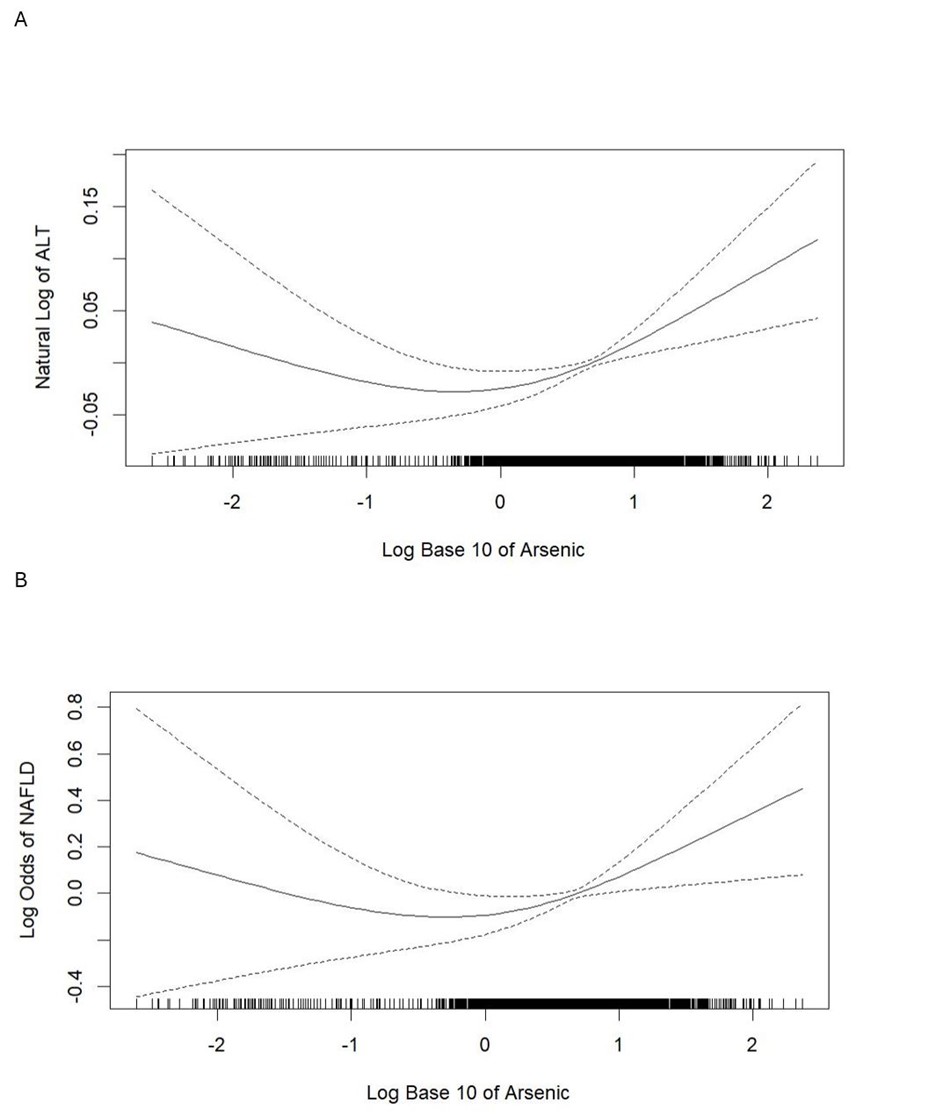Monday Poster Session
Category: Liver
P2961 - Arsenic in the Body: Assessing its Role in Metabolic Dysfunction and Liver Steatosis
Monday, October 28, 2024
10:30 AM - 4:00 PM ET
Location: Exhibit Hall E

Has Audio

Silpa Choday, MD
Creighton University School of Medicine
Phoenix, AZ
Presenting Author(s)
Silpa Choday, MD1, Phillip Leff, DO2, Sunanda Ellina, MD1, Gautam Maddineni, MD3, Justin A. Reynolds, MD1
1Creighton University School of Medicine, Phoenix, AZ; 2Creighton University School of Medicine, Scottsdale, AZ; 3Florida State University, Cape Coral, FL
Introduction: While associated with obesity, the cause of the rapid rise in prevalence of metabolic dysfunction associated steatotic liver disease (MASLD) is not well understood. Animal experiments have demonstrated that arsenic exposure contributes to liver injury. Our objective was to examine the association between arsenic exposure and MASLD in humans.
Methods: Urinary inorganic arsenic in the National Health and Nutrition Examination Survey (NHANES), 2011–2020 were used. Participants with common risk factors of liver disease, high alcohol consumers, positive hepatitis B or C, those missing body mass index and pregnant women are excluded. Data from NHANES were combined with death certificate data from the National Center of health Statistics from the National Death Index to ascertain mortality rates. Serum ALT was used to determine the presence of MASLD, a marker of liver dysfunction. Weighted linear regression was used to compare continuous variables between groups, while Chi-squared analysis was used to compare categorical variables.
Results: The analysis included 6,386 participants after exclusions. The mean arsenic level was 5.92 µg/L with MASLD Versus 5.59 µg/L without. ALT levels exhibited a statistically significant increasing trend across both continuous arsenic levels and arsenic quintiles. A statistically significant upward trend was observed in the income-to-poverty ratio and BMI but not in the education status. MASLD prevalence was highest among the white population, while an increasing trend is observed in Hispanic population over the years (p < 0.001). The proportion of Mexican Americans increased to 12.6% in the MASLD group versus 8.09% in the non-MASLD cohort (p < 0.001). There is a statistically significant increase in the odds of MASLD, with a 32% higher likelihood in the highest arsenic quintile compared to the lowest (P-trend = 0.002). The odds increased to 55% in the highest quintile compared to the lowest (OR 1.55, 95% CI 1.19-2.03; P-trend < 0.001). It is predominant in females compared to males (47.6% vs. 57.9%; p < 0.001), and the mean age rose from 46.9 years to 49.9 years (p = 0.016). The mean body mass indices (BMI) also increased from 28.9 kg/m² to 30.0 kg/m² during the same period.
Discussion: Our findings reveal a positive association between urinary arsenic exposure and MASLD, with increasing trends particularly observed among Hispanics, and significant association noted between income to poverty ratios and BMI.

Note: The table for this abstract can be viewed in the ePoster Gallery section of the ACG 2024 ePoster Site or in The American Journal of Gastroenterology's abstract supplement issue, both of which will be available starting October 27, 2024.
Disclosures:
Silpa Choday, MD1, Phillip Leff, DO2, Sunanda Ellina, MD1, Gautam Maddineni, MD3, Justin A. Reynolds, MD1. P2961 - Arsenic in the Body: Assessing its Role in Metabolic Dysfunction and Liver Steatosis, ACG 2024 Annual Scientific Meeting Abstracts. Philadelphia, PA: American College of Gastroenterology.
1Creighton University School of Medicine, Phoenix, AZ; 2Creighton University School of Medicine, Scottsdale, AZ; 3Florida State University, Cape Coral, FL
Introduction: While associated with obesity, the cause of the rapid rise in prevalence of metabolic dysfunction associated steatotic liver disease (MASLD) is not well understood. Animal experiments have demonstrated that arsenic exposure contributes to liver injury. Our objective was to examine the association between arsenic exposure and MASLD in humans.
Methods: Urinary inorganic arsenic in the National Health and Nutrition Examination Survey (NHANES), 2011–2020 were used. Participants with common risk factors of liver disease, high alcohol consumers, positive hepatitis B or C, those missing body mass index and pregnant women are excluded. Data from NHANES were combined with death certificate data from the National Center of health Statistics from the National Death Index to ascertain mortality rates. Serum ALT was used to determine the presence of MASLD, a marker of liver dysfunction. Weighted linear regression was used to compare continuous variables between groups, while Chi-squared analysis was used to compare categorical variables.
Results: The analysis included 6,386 participants after exclusions. The mean arsenic level was 5.92 µg/L with MASLD Versus 5.59 µg/L without. ALT levels exhibited a statistically significant increasing trend across both continuous arsenic levels and arsenic quintiles. A statistically significant upward trend was observed in the income-to-poverty ratio and BMI but not in the education status. MASLD prevalence was highest among the white population, while an increasing trend is observed in Hispanic population over the years (p < 0.001). The proportion of Mexican Americans increased to 12.6% in the MASLD group versus 8.09% in the non-MASLD cohort (p < 0.001). There is a statistically significant increase in the odds of MASLD, with a 32% higher likelihood in the highest arsenic quintile compared to the lowest (P-trend = 0.002). The odds increased to 55% in the highest quintile compared to the lowest (OR 1.55, 95% CI 1.19-2.03; P-trend < 0.001). It is predominant in females compared to males (47.6% vs. 57.9%; p < 0.001), and the mean age rose from 46.9 years to 49.9 years (p = 0.016). The mean body mass indices (BMI) also increased from 28.9 kg/m² to 30.0 kg/m² during the same period.
Discussion: Our findings reveal a positive association between urinary arsenic exposure and MASLD, with increasing trends particularly observed among Hispanics, and significant association noted between income to poverty ratios and BMI.

Figure: Generalized Additive Models to assess linearity between Arsenic Levels and ALT (A), prevalence of NAFLD (B),
Note: The table for this abstract can be viewed in the ePoster Gallery section of the ACG 2024 ePoster Site or in The American Journal of Gastroenterology's abstract supplement issue, both of which will be available starting October 27, 2024.
Disclosures:
Silpa Choday indicated no relevant financial relationships.
Phillip Leff indicated no relevant financial relationships.
Sunanda Ellina indicated no relevant financial relationships.
Gautam Maddineni indicated no relevant financial relationships.
Justin Reynolds: Gilead – Speakers Bureau. Madrigal Pharmaceuticals – Speakers Bureau. Novo Nordisk – Consultant.
Silpa Choday, MD1, Phillip Leff, DO2, Sunanda Ellina, MD1, Gautam Maddineni, MD3, Justin A. Reynolds, MD1. P2961 - Arsenic in the Body: Assessing its Role in Metabolic Dysfunction and Liver Steatosis, ACG 2024 Annual Scientific Meeting Abstracts. Philadelphia, PA: American College of Gastroenterology.
